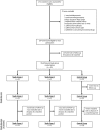Grape or grain but never the twain? A randomized controlled multiarm matched-triplet crossover trial of beer and wine
- PMID: 30753321
- PMCID: PMC6410559
- DOI: 10.1093/ajcn/nqy309
Grape or grain but never the twain? A randomized controlled multiarm matched-triplet crossover trial of beer and wine
Abstract
Background: Alcohol-induced hangover constitutes a significant, yet understudied, global hazard and a large socio-economic burden. Old folk wisdoms such as "Beer before wine and you'll feel fine; wine before beer and you'll feel queer" exist in many languages. However, whether these concepts in fact reduce hangover severity is unclear.
Objectives: The aim of this study was to investigate the influence of the combination and order of beer and wine consumption on hangover intensity.
Methods: In this multiarm, parallel randomized controlled matched-triplet crossover open-label interventional trial, participants were matched into triplets and randomly assigned according to age, gender, body composition, alcohol drinking habits, and hangover frequency. Study group 1 consumed beer up to a breath alcohol concentration (BrAC) ≥0.05% and then wine to BrAC ≥0.11% (vice versa for study group 2). Control group subjects consumed either only beer or only wine. On a second intervention day (crossover) ≥1 wk later, study-group subjects were switched to the opposite drinking order. Control-group subjects who drank only beer on the first intervention received only wine on the second study day (and vice versa). Primary endpoint was hangover severity assessed by Acute Hangover Scale rating on the day following each intervention. Secondary endpoints were factors associated with hangover intensity.
Results: Ninety participants aged 19-40 y (mean age 23.9), 50% female, were included (study group 1 n = 31, study group 2 n = 31, controls n = 28). Neither type nor order of consumed alcoholic beverages significantly affected hangover intensity (P > 0.05). Multivariate regression analyses revealed perceived drunkenness and vomiting as the strongest predictors for hangover intensity.
Conclusions: Our findings dispel the traditional myths "Grape or grain but never the twain" and "Beer before wine and you'll feel fine; wine before beer and you'll feel queer" regarding moderate-to-severe alcohol intoxication, whereas subjective signs of progressive intoxication were confirmed as accurate predictors of hangover severity. This trial was prospectively registered at the Witten/Herdecke University Ethics Committee as 140/2016 and retrospectively registered at the German Clinical Trials Register as DRKS00015285.
Figures





References
-
- Rehm J, Mathers C, Popova S, Thavorncharoensap M, Teerawattananon Y, Patra J. Global burden of disease and injury and economic cost attributable to alcohol use and alcohol-use disorders. Lancet. 2009;373(9682):2223–33. - PubMed
-
- Ma C, Bovet P, Yang L, Zhao M, Liang Y, Xi B. Alcohol use among young adolescents in low-income and middle-income countries: A population-based study. Lancet Child Adolesc Health. 2018;2(6):415–29. - PubMed
-
- Williams R, Alexander G, Armstrong I, Baker A, Bhala N, Camps-Walsh G, Cramp ME, de Lusignan S, Day N, Dhawan A et al. .. Disease burden and costs from excess alcohol consumption, obesity, and viral hepatitis: Fourth report of the Lancet Standing Commission on Liver Disease in the UK. Lancet. 2018;391(10125):1097–107. - PubMed
Publication types
MeSH terms
Substances
Associated data
LinkOut - more resources
Full Text Sources
Medical

